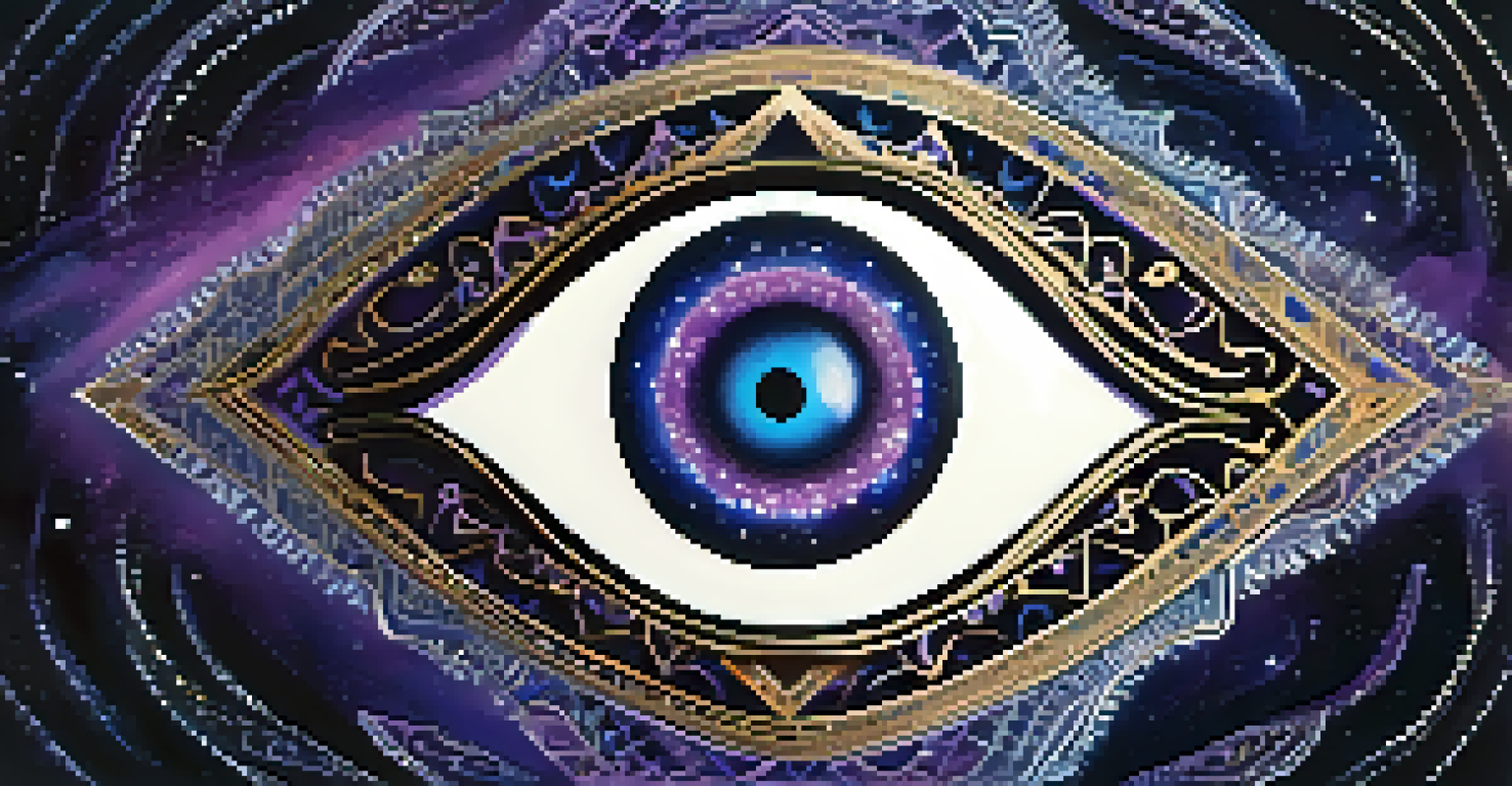Exploring Religious Symbols in Hollywood: A Cultural Lens

The Power of Symbols in Filmmaking
Symbols serve as a powerful storytelling tool in films, allowing filmmakers to convey complex ideas succinctly. In Hollywood, religious symbols often play a pivotal role, enriching narratives and connecting with audiences on a deeper, emotional level. For instance, a simple cross can evoke themes of sacrifice, redemption, or faith, depending on its context within the film.
Cinema is a mirror by which we often see ourselves.
When directors choose to incorporate religious imagery, they tap into a well of cultural significance that resonates with viewers. This can create a shared understanding or provoke thought, encouraging audiences to reflect on their own beliefs and experiences. The use of symbols can thus transform a movie into a dialogue about spirituality, morality, and humanity.
Ultimately, these symbols bridge the gap between entertainment and exploration of profound themes. By engaging with religious symbols, filmmakers invite audiences to see beyond the screen, fostering a deeper connection to the story and its underlying messages.
Iconic Religious Symbols in Hollywood Films
Hollywood has a rich history of incorporating religious symbols, from the iconic cross to the all-seeing eye. Movies like 'The Da Vinci Code' and 'The Ten Commandments' showcase these symbols prominently, prompting audiences to engage with the narrative on a spiritual level. Such films often explore themes of faith, doubt, and the search for meaning, using symbols as visual shorthand for complex ideas.

Consider the use of the cross in 'The Passion of the Christ.' It serves not only as a religious symbol but also as a poignant reminder of sacrifice and redemption. The film's powerful imagery invites viewers to reflect on their own beliefs, making the experience deeply personal.
Symbols Enhance Film Storytelling
Religious symbols in films serve as powerful tools to convey complex themes and provoke deep emotional connections with audiences.
Similarly, films like 'The Matrix' utilize religious motifs, such as the concept of a savior figure, to explore existential themes. By embedding these symbols within their stories, filmmakers create layers of meaning that encourage audiences to ponder their own spiritual journeys.
Religious Symbols and Character Development
In many films, religious symbols are intricately tied to character arcs, revealing their inner struggles and growth. For example, a character's journey towards redemption often involves encounters with religious imagery that challenge their beliefs. This creates a compelling narrative thread, as viewers watch characters grapple with their faith and moral dilemmas.
Filmmaking is a chance to live many lifetimes.
Take the film 'Atonement,' where the protagonist's guilt and quest for forgiveness are mirrored through recurring motifs of light and dark. These symbols reflect her internal conflict, making her eventual redemption all the more impactful. Such character-driven narratives draw audiences in, allowing them to empathize with the struggles portrayed on screen.
Ultimately, the integration of religious symbols into character development enriches the storytelling experience. It adds depth to characters, making their journeys relatable and their struggles resonate with viewers from various backgrounds.
Controversial Uses of Religious Symbols
While the use of religious symbols can enhance storytelling, it can also lead to controversy. Films like 'The Last Temptation of Christ' faced backlash for their provocative interpretations of biblical narratives. Such reactions highlight the diverse beliefs held by audiences, and how they interpret symbols can differ widely.
This controversy often sparks important conversations about the portrayal of religion in media. Filmmakers must navigate these sensitive waters carefully, balancing creative expression with respect for deeply held beliefs. The challenge lies in presenting narratives that provoke thought without alienating segments of the audience.
Cultural Context Shapes Interpretation
The meaning of religious symbols can vary significantly across cultures, making it crucial for filmmakers to consider their audience's diverse beliefs.
Ultimately, these discussions can lead to a broader understanding of cultural perspectives. By addressing the complexities of religious symbolism in Hollywood, filmmakers can contribute to a more nuanced dialogue about faith, spirituality, and artistic freedom.
Cultural Context and Symbol Interpretation
The interpretation of religious symbols is heavily influenced by cultural context. What resonates in one culture may not hold the same significance in another, making it essential for filmmakers to consider their target audience. For instance, a film that draws on Christian symbols may be interpreted differently by audiences from diverse religious backgrounds.
In films like 'Life of Pi,' the use of religious symbols transcends specific faiths, inviting viewers to explore universal themes of hope and resilience. This approach allows for a broader interpretation, fostering inclusivity and understanding among audiences of various beliefs.
Cultural context enriches the viewing experience, offering layers of meaning that can lead to deeper reflections. By understanding the cultural significance of symbols, filmmakers can create stories that resonate across diverse audiences while encouraging thoughtful discourse.
The Role of Religion in Hollywood Narratives
Religion has always been a significant theme in Hollywood, serving as a backdrop for many narratives. Many films explore the relationship between faith and morality, questioning societal norms and personal beliefs. This exploration often leads to compelling storytelling that resonates with audiences on multiple levels.
Consider 'Schindler's List,' where religious themes are woven into the fabric of the narrative to highlight moral choices amidst tragedy. The film's portrayal of sacrifice and humanity sparks profound reflections on faith and the human condition, making it a powerful cinematic experience.
Evolving Spiritual Themes in Cinema
Contemporary films are increasingly exploring spirituality beyond traditional frameworks, reflecting a more inclusive representation of diverse beliefs.
By embedding religious themes within their plots, filmmakers encourage viewers to confront their own values and beliefs. This not only enriches the storytelling but also fosters a deeper connection between the audience and the characters they encounter.
Future Trends: The Evolution of Religious Symbols in Film
As society evolves, so too does the portrayal of religious symbols in Hollywood. Contemporary films are increasingly exploring themes of spirituality beyond traditional religious frameworks, reflecting a more diverse array of beliefs. This shift opens the door for new interpretations and representations of spirituality on screen.
For example, films like 'Everything Everywhere All at Once' incorporate elements of various belief systems, offering a more holistic approach to spirituality. This trend highlights the growing recognition of diverse narratives and the need for inclusivity in storytelling.

Looking ahead, the evolution of religious symbols in film promises to challenge conventions and expand the discourse around faith and spirituality. As filmmakers continue to innovate, audiences can expect more nuanced and thought-provoking representations of the complexities of belief.